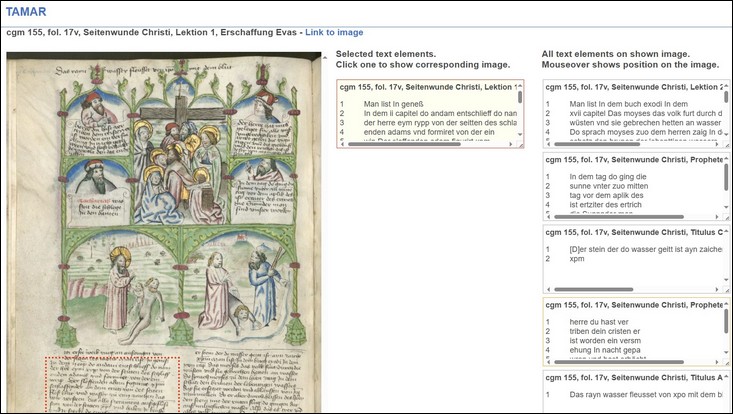New Web Tool: Transcriptions and Annotations for Manuscript Research
10 June 2025

Photo: CSMC
TAMAR, a new web tool providing transcriptions and visualisations of Biblia pauperum manuscripts, enhances access, research, and teaching. The tool can also be used for other research projects.
During the late Middle Ages, European manuscript culture underwent significant change. As urban, educated elites grew in number and influence, they wanted books in their own languages rather than only in Latin, leading to translations, rewritings, and new ways of organising and illustrating texts. Large, multi-text manuscripts — sometimes called ‘one-volume libraries’ —collected many different works, such as the Biblia Pauperum, for religious education and general knowledge, especially in German-speaking regions. In a project entitled ‘Reframing Old Contents for New Readers in Late-Medieval German One-Volume Libraries’ (FNT08), Hanna Wimmer and Malena Ratzke investigated how this book culture evolved, and how manuscripts influenced, and were influenced by, emerging print technologies.
In collaboration with ‘Data Linking’ (Research Field F), in particular with Ralf Möller and Stefan Thiemann, this project developed the web application TAMAR (Transcriptions & Annotations for Manuscript Research), which has recently been published. TAMAR is a collection of working transcriptions of selected passages from Biblia pauperum manuscripts, which are stored as a dataset in the research data repository of the University of Hamburg and can be visualised in a browser.
The application is intended to facilitate work with the Biblia Pauperum in both research and teaching: It visualises transcriptions from the Biblia pauperum in direct connection with the digitised version of the respective manuscript page, allowing researchers to trace how the visual organisation of the pages changed over time, especially with regard to their transmission in multiple-text manuscripts. Moreover, TAMAR allows students to engage in scholarly work on medieval literature and art and to develop palaeographic skills.
Until now, access to the Biblia pauperum tradition has been anything but easy. There are no scholarly editions in either digital or analogue form, and transcriptions of individual manuscripts have often been published in expensive facsimile editions or monographs that have long been out of print. Many of the manuscripts, however, are available in digital form.
In addition to the web version, there is a version of TAMAR that can be opened with a special CSMC online previewer. This ensures long-term availability and reliable citation in accordance with the FAIR principles of research data management. It also enables broad use in various application scenarios for which TAMAR is also suitable, such as the visualisation of measurement data from materials science investigations of written artefacts.

